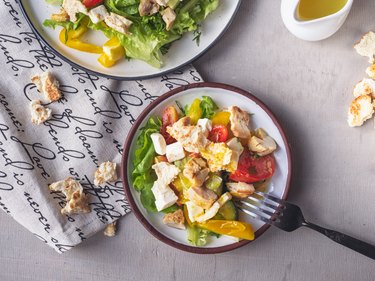
If you thought packing a salad for lunch would grant you a one-way ticket to healthy eating, you'll be disappointed by how quickly things can go south.
The truth is that it only takes a few missteps to turn a balanced, nutrient-packed salad into a bowl full of salt, sugar and saturated fat — not to mention a calorie overload. We asked registered dietitians to sort through the confusion and reveal the absolute worst and best salad ingredients to build a better bowl.
Video of the Day
Video of the Day
The Worst Salad Ingredients
1. Croutons
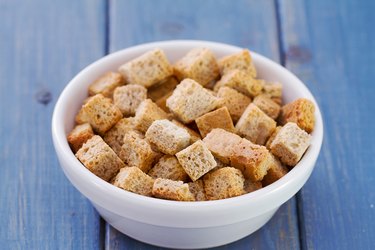
"Croutons are generally white bread drenched in fat and salt," says Abby Langer, RD, owner of Abby Langer Nutrition in Toronto. There's just nothing there, nutritionally speaking.
Langer notes they are not the most terrible ingredient to add to your salad, perhaps in part because of their tiny portion size (two tablespoons of croutons contain about 20 calories). However, she still cautions to severely limit the number of croutons you add to your bowl since that two-tablespoon serving is "probably a lot less than what most people use in a salad."
It's not hard to sprinkle half a cup over your salad, adding 80 calories to your meal instantly. If you love croutons, try taking just a few and breaking them up so there's more crouton per bite.
2. Wonton Strips
Salads are about greens and fresh produce, so say no to anything fried. Crunchy wonton strips are "just crappy fried dough with pretty much zero nutrition," according to Langer, who minces no words in her disdain for those tasty fried noodles. To make matters worse, she adds that they're not a treat worth splurging for. "They're usually high in oil and rancid-tasting too. Nothing here to see, people. Move on."
3. Deli Meat
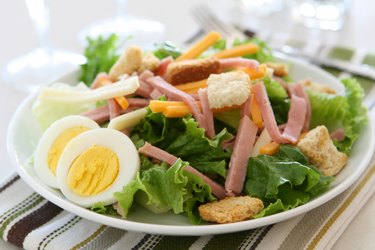
Making a balanced meal means finding healthy sources of protein. Deli meat definitely has protein, but at a high sodium cost and an increased risk of colorectal cancer, according to the World Health Organization.
Just four slices of turkey can push you close to the Recommended Dietary Allowance (RDA) of 2,300 milligrams or about one teaspoon. Calories can vary widely, from lean turkey breast on the lower end to salami on the higher end (the dead giveaway is all that visible solid fat).
4. Ranch Dressing
Just so we don't single out one unhealthy dressing from the others, the warning against drowning your salad in ranch also applies to thousand island, Caesar and blue cheese dressings. What do they all have in common? They add a surprising amount of saturated fat and calories to your bowl.
Langer offers a tip: "If you must, take a small cup and dip your fork into the dressing before spearing the salad." Her logic? That way you'll get all the flavor without the intense calorie bomb. A meager two-tablespoon serving (about one-eighth of a cup) of any of these popular bottled dressings will cost you more than 100 calories — and even more if you don't watch that small serving size.
5. Bacon Bits
Christy Wilson, RD, nutrition counselor at University of Arizona Campus Health Service and owner of Christy Wilson Nutrition, admits that bacon bits add that perfect salty, smoky flavor to your salad. "But, their salt and concentrated calorie content make them a bust," Wilson says, adding that you shouldn't be fooled by their protein content.
Many bacon bits are considered "imitation," made from textured soy flour, so you have to consider the added salt and sugar. "Real" bacon bits, however, are made with processed meat that has either been cured, salted or smoked. Wilson says this is a problem because "there is evidence that frequent intake of highly processed meats like bacon can lead to blood vessel damage and increase risk of stroke and cancer." Either way, they're not winning any nutrition prizes.
6. Candied Nuts
Yes, nuts are one of the healthiest foods you can eat. However, "Covering heart-healthy nuts in a sugary coating takes away from their nutrient value," says Mandy Enright, MS, RDN and creator of Nutrition Nuptials.
Americans are getting too many of their calories from added sugar, which can lead to obesity, type 2 diabetes and heart disease. That's why the American Heart Association recommends no more than six teaspoons, or about 25 grams, of added sugar per day for women, and nine teaspoons, or about 36 grams, for men.
7. Dried Fruit
Much like candied nuts, dried fruits are another common culprit adding sneaky sugar to your salads for the same reason. Hidden sugar sabotages healthy foods like nuts and dried fruit, making healthy eating harder than it has to be. Avoid the cranberries and Craisins, and opt for fresh fruit in your salad instead.
The Best Salad Ingredients
1. Baby Spinach
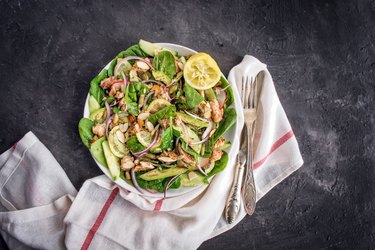
Low in calories and high in nutrition, baby spinach is "a powerhouse of fiber, antioxidants and vitamins A and K," says Langer. That's a nutritional bargain for single-digit calories per cup. The body can use those antioxidants all day long to fight off chronic inflammation from external sources such as pollution, fast food and added sugar.
It's not a shocker that leafy greens are one of the best things you can eat. What's great about baby greens is that they're less bitter than their full-grown counterparts. In addition to baby spinach, try baby kale, baby arugula and baby mixed greens.
2. Edamame
The mildly nutty young green soybeans should be one of the first foods you think of for plant protein and fiber. Make some room in your day for more plant protein and less meat, and you'll be on your way to a healthier heart and reduced risk of type 2 diabetes, high blood pressure, obesity and certain cancers, according to a report in Journal of the Academy of Nutrition and Dietetics.
Plant-based foods are also better for the environment because plants use fewer natural resources and take a lesser toll on the environment. No, this does not mean you need to be 100 percent vegetarian (though it is totally fine if you are), but we should all be eating more plants, period. Black beans and chickpeas are also excellent plant-based proteins you should add to your bowl.
Read more: Soup and Salad Diet
3. Shredded Brussels Sprouts
Finding shredded Brussels sprouts at your local market is always a treat for a couple of reasons. One, someone else has done all the work of trimming and shredding them for you (score!). And, two, "these cruciferous, cancer-fighting little cabbages," as Langer refers to them, can become tender and delicious in their shredded form when combined with a dash of dressing and a little time. They are a truly outstanding source of the major antioxidant vitamin C (good for fighting all kinds of harmful free radicals in the body) as well as a source of potassium for healthy muscles and replenishing electrolytes.
4. Carrots
The bright and vivid orange color of carrots is a dead giveaway that you are in the presence of a great source of vitamin A carotenoids. These vitamins help to keep you looking younger longer, among other benefits, says Langer. The crunch and high water content of carrots means that you'll fill up, not out. Pair them with cucumbers, celery and jicama for a wholesome salad.
5. Tomatoes
Tomatoes are bursting with color (thanks to their antioxidants) and have a juicy, mild sweetness that works great in contrast to earthy greens in a salad. Langer agrees that they're a delicious way to add nutrition to your salad. She likes that they are "packed with vitamin C and lycopene, a cancer-fighting antioxidant." In fact, her advice is to pile them on, since each cherry tomato is just a few calories a pop. That sounds like advice to remember for life.
6. Pistachios and Almonds
Yes, nuts in general are good for you, but as Wilson explains, "pistachios and almonds are healthy options not only because they provide heart-healthy and satisfying unsaturated fats, but they also have six grams of plant-based protein per one-ounce serving." Pistachios and almonds are the highest-protein and filled with fiber, so you can stay fuller longer. Wilson adds that they "naturally contain blood pressure-lowering minerals, including magnesium and potassium."
7. Quinoa
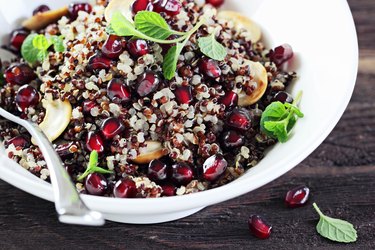
People don't always think about whole grains for plant protein, but they're actually a super healthy and reliable source of it. And every little bit counts, right? If you're looking for some plant protein and filling high-quality carbohydrates, scoop some quinoa onto your salad. Other viable options are wild rice, farro, barley, sorghum or any other interesting whole grain.
Tip
Cover your salad container with a tight lid and shake it up so that the grains will evenly distribute throughout the salad.
8. Hard-Boiled Eggs
Protein-packed eggs are one of the only commonly available foods that provide a good source of vitamin D. This is good news for people who don't get enough vitamin D from sun exposure — whether it's due to living too far north, winter daylight hours or, like many of us, from working inside all day. Just remember, you only get the bone-building and inflammation-fighting vitamin D (11 percent of the daily value) if you eat the whole egg, as the treasure is in the golden yolk.
9. Olive Oil and Vinegar
Oftentimes, bottled salad dressings include added sugars, salt and preservatives — which is why we recommend making your own! Extra-virgin olive oil is widely praised for its complex array of antioxidant and anti-inflammatory polyphenols as well as its role as a heart-healthy, diabetes-friendly and brain-boosting healthy fat. Olive oil also helps the body absorb all the great fat-soluble vitamins (vitamins A, D, E and K) trapped in the greens in your salad.
And vinegar, while not a cure-all magical potion, offers polyphenols and probiotics for minimal calories. Together they add a punch of flavor and can magically bring a salad together.
10. Fresh Fruit
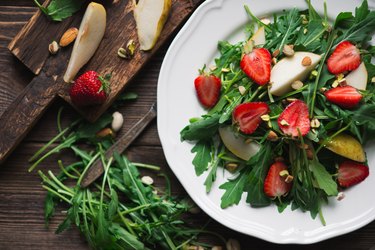
We've come a long way from the days of basic iceberg, tomato and cucumber salads. There's no shame in including these in your salad, but we've really expanded our ideas and expectations of what can go in a salad, as evidenced by the variety of add-ins seen at modern salad bars. So don't just think veggies, but also consider where fruit plays a role.
As a rule, add only fresh fruit and avoid anything in syrup or other dressing. Fresh fruit delivers natural sweetness (yum!) along with essential nutrients and hydrating water content — without all the added sugar. Some top picks to add are blueberries, strawberries and mandarin orange segments.
- American Heart Association: "Added Sugars"
- Journal of the Academy of Nutrition and Dietetics: "Position of the Academy of Nutrition and Dietetics: Vegetarian Diets"
- National Institutes of Health: "Vitamin D"
- World Health Organization: "Q&A on the Carcinogenicity of the Consumption of Red Meat and Processed Meat"
- CDC: "Sodium and the Dietary Guidelines"
- CDC: "Know Your Limit for Added Sugars"